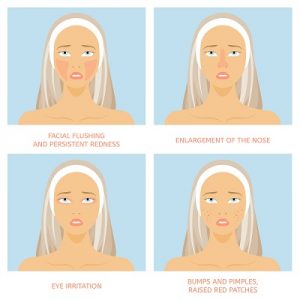Rosacea
 Skin conditions can have a major impact on how people view themselves, so there is a tremendous effort to be able to control how your skin looks, but for some, there are persistent disorders that can impact their social life.
Skin conditions can have a major impact on how people view themselves, so there is a tremendous effort to be able to control how your skin looks, but for some, there are persistent disorders that can impact their social life.
Rosacea is a skin condition that causes a sort of redness of the skin over various areas of the body. People who suffer from rosacea often believe that it is another type of skin condition like adult acne when signs first appear.
Symptoms and Signs
The earliest signs that you have rosacea are often flushing, or a blushing appearance to the skin. Soon after that, the skin and blood vessels in the face often become hypersensitive, resulting in blood vessels becoming engorged or swollen at a slight touch.
In some cases, the skin may begin to produce small pustules of pus on the surface. If the condition worsens, it may also lead to the thinking of the skin on the face and nose. This is what is responsible for the bulbous noses seen in the past. If you treat your rosacea early on, it might not progress to the later symptoms. Continue reading
It’s been noted that when people who live with rosacea learn about their condition, they cope with it and deal with the effects much more effectively than those who actively avoid information.
Understanding that there are different types and lengths of time that affect the outcome of your appearance can help you to safeguard yourself and prevent the possibility of having to have expensive surgeries to correct damaged tissues.
Facial Redness
Early on, the first symptoms of rosacea are usually a type of flushing, or blushing that takes places on the face around the nose and on the cheeks. At the earliest stage, the redness will subside, and go back to normal until a triggering event takes place.
As it progresses, the flushing begins to stay a little longer and may stay permanently. Small blood vessels might burst leaving swollen skin. Sometimes this cause the skin to become a sort of large scar, growing in thickness or even becoming a sort of scaled flesh. Continue reading






